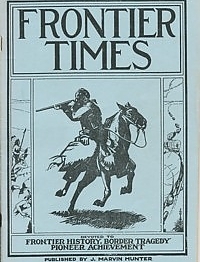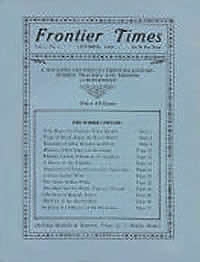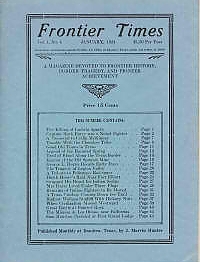By using our website, you agree to the use of cookies as described in our Cookie Policy
Magazines & Instant Downloads
Vol 11 No. 01 - October 1933
Ellis P. Bean, a Bold Pioneer
In the year 1800, Ellis P. Bean, then a boy of eighteen, possessed with a spirit of adventure, left his father's home at Bean's station, Tennessee, and reaching Natchez on the Mississippi, enlisted in the trading company of Philip Nolan, then en route for Texas. The company consisted of twenty-two men, having in charge a large amount of goods.
Reaching Texas, and while at a point between the Trinity and Brazos rivers they were attacked by a body of Spanish troops. Nolan and his men made a desperate resistance, but were finally overpowered. Thirteen, including Nolan, were killed, and the remaining nine, with Bean, made prisoners. The prisoners were taken to San Antonio, and there confined several months. Thence they were sent to Chihuahua, by way of Monclova, and there chained and imprisoned. Thus they were kept three years, when they were allowed the privileges of the city limits, and labor for themselves. Bean had learned the hatting business, and he followed it for a year in Chihuahua, when his longing to see his native land induced him, with two comrades, to run away and endeavor to reach the United States. The three were arrested near El Paso, severely lashed, and again ironed and imprisoned.
Bean's many friends in Chihuahua soon obtained for him again the freedom of the city, and he made a second effort to escape, but was again taken. He was now sent under a strong guard to the south of Mexico. On their way they came to the city of Guanajuato, where they remained several days. While there, Bean's noble and manly bearing won the heart of a beautiful Mexican senorita of rank, who wrote a letter to him avowing her passion, and promising her influence to obtain his liberation; when she would bestow upon him her hand and fortune. But he was hurried away, and never permitted to see her. Poor Bean was next conveyed to Acapulco, one of the most sickly places on the Pacific, and thrown into a filthy dungeon, where no ray of light of heaven penetrated, and the only air admitted was through an aperture in the base of the massive wall, which was six feet thick. In this foul abode his body was covered with vermin; no one was allowed to see him, and his food was of the coarsest and most unhealthy kind. In his confinement his only companion was a white lizard, which he succeeded in taming, and which became very fond of him.
The only air-hole had to be closed at night to prevent the ingress of serpents. One night, having neglected to close it, he was awakened by the crawling of a monstrous serpent over his body. His presence of mind enabled him to lie perfectly still until, getting hold of a pocket knife which he had been able to keep concealed on his person, he pierced the monster in the head and escaped his fangs. This exploit so astonished the keeper of the prison that by his influence a petition was sent to the governor for a mitigation of his confinement. That dignitary graciously decreed that he might work in chains, and under a guard of soldiers. Even this was a relief. Bean's noble desire for freedom again overcame his prudence. He succeeded in freeing himself from shackles, and with a piece of iron killed three of the guard, and fled to the mountains. Again he was hunted down and recaptured, nearly starved. His cell now became his only abode, and flogging and other indignities were heaped upon him. Another year passed, and he was again allowed the liberty of the prison yard under strict surveillance.
Once more he made a desperate attempt to escape, killing several soldiers, and taking the road to California. This time he had traveled 300 miles, when he was once more recaptured and carried back…This is an excellent story.
Aboriginal Antiquities of Texas
J. H. Kuykendall, Rockport, Texas, in 1869. The prehistoric remains of man and his arts found in the tumuli of the Mississippi valley indicate that that country was once inhabited by more civilized people than the red men; yet the former may have preceded the latter in the occupation of this continent, for the flint arrow-heads found in innumerable localities throughout this State (and indeed throughout this continent,) buried in some instances several feet beneath the surface in alluvium, attest the presence here of the red race untold ages before the advent of the "pale-faces." These tiny monuments of the American aborigines are, in fact more enduring than the pyramids of Egypt, and thousands of years hence they will continue to be turned up by the plow of the farmer, looking almost as fresh and untarnished as when they were first wrought from the pebbles in the early ages of human existence.
Further Mentions: Carankawas; San Antonio and La Bahia, where they doubtless obtained copper, brass and iron, all of which metals they used for pointing their missiles; Ingleside; a, little Golgotha was discovered in a sand-hill near what is locally known as the "False Live Oak," in Refugio County; G. W. Wiseman; the Dove Creek fight; B. P. Lee; Mrs. Emma L. Lee;
Barbecue; the Ghosts Walk
By Coleman McCampbell, Corpus Christi, Texas
ONCE A YEAR, each July at the spacious and eerie two-story frame mansion of the Misses Lydia and Mary Dougherty, on the San Patricio site of the historic McGloin & McMullen settlement of Irish colonists in Texas, the past lives again, in the form of a barbecue reunion. The mansion, which for generations in the nineteenth century housed St. Paul's Academy under the guidance of Prof. Robert Dougherty, overlooks Round Lake and is set in a topical landscape of mesquite and husache thickets, of prickly pear cactus, of fields of cotton, and of jacal huts for the Mexican hands. It is far from the main road; it has remoteness that comes from cloistered isolation ; it has a soft and blurred patine of traditions, phantoms, intriguing legends. The massive furniture is of another period; the walls of the interior are clustered with endless groups of fascinating photographs and portraits of McGloins, Doughertys, Sullivans, Bluntzers, in costumes of long ago. As you walk across the bare plank floors, from chamber to chamber, you tread gently, with an unconscious and muted reverence. There is laughter, warm welcome in the eyes and voices of guests and hostesses, quick turns of the head, spirited greetings and gossip; and yet, the atmosphere of the house and setting triumphs, like a twilight glow, like a diffusing nimbus, for it is an atmosphere of repose, of deep and rich secrets, waiting to gain your confidence, waiting to whisper into your ear of the days and happenings that may be past but are still vivid and remembered. This is an excellent article dealing with the early Irish settlements of South TX.
Further Mentions: Judge Walter Tinlon; Robert Bluntzer, a nephew of the Dougherty sisters; Mrs. Vincent Bluntzer, Robert's mother; Miss May Francis Hunter, a granddaughter of D. C. Rachal (early settler at White Point and big cow man of the SO's,); Edna May Tubbs of Bishop; Banquete, El Lugar del Banquete (the place of the banquet,) a lake formed by a creek and ten miles south of San Patricio settlement; Capt. Rodriquez, in command of Fort Lipantitlan; Father T. J. Malloy; General Garcia, a Texas sympathizer;
A Kimble County Pioneer Passes
The article includes an excellent photo of Mr. Browning. And it is also excellent early Kimble co. history.
Account of James Alfred Browning, one of Kimble's most honored citizens. Browning was born February 3, 1857, in Guadalupe county. 10 miles south of Seguin. He lived in Gaudalupe and Gonzalas counties until he was 17 years old when he moved with his family to Kimble county, settling at the mouth of Gentry Creek, near where he was buried. His mother died in 1875, his father, A. P. Browning, then returned to Guadalupe county for a while but later came back to Kimble county and died here in 1904. As a young man before he began his service in an official capacity, he worked on ranches, served as clerk in stores, acted as bartender, drove teams, worked in the post-office, fiddled for dances, hunted bee trees, hunted wild game, and caught fish from the Llanos. His wages were small, but in 1884 the late G. W. Hodges paid him $20 a month, which he considered big wages. From these earnings, he saved enough money to enter the stock business in 1885. After his election as tax assessor in 1886, he retired from ranch business and devoted his time and talents to serving the people of Kimble county.
Further Mentions: Horace Teddlie; the Gentry Cemetery; Miss Josie Childs; A. W. Browning, Junction; Mrs. Lelia Fischer, Junction; Mrs. Bessie Bolt, Junction; Mrs. Virgie Lucke, Del Rio; Mrs. Alexa Zipp, San Antonio; three brothers, J. B. Browning, Bood Browning, A. C. Browning; three sisters, Mrs. Jess Schrier, Mrs. Mary, Roberts, Mrs. Lee Southall, two half sisters, Mrs. Joe Tilley and Mrs. Willie Sambreskey; E. M. Browning, Corpus Christi; Sheriff W. W. Taylor; He was here when Isaac Kountz, a Mr. Spear, and members of the Dowdy family were killed by marauding Indians; L. M. Walton; Kimbleville on the Will Taylor place one and one-half miles north-east of Junction; R. C. Ledbetter;
WHAT A DIFFERENCE FIFTY YEARS MAKE
1883-Fifty years ago women wore hoopskirts, bustles, petticoats, corsets, cotton stockings, high buttoned shoes, ruffled cotton drawers, flannel night gowns, puffs in their hair and did their own cooking, baking, cleaning, washing, ironing-raised big families-went to church Sunday-were too busy to be sick…etc, etc
Five Years a Cavalryman
By H. H. McConnell. Ongoing, detailed and day-to-day journal recounting McConnell’s experiences are further related in this installment of his excellent story. To read this account is like being along for the ride. Frontier history comes alive in these pages, from the back of a great Calvaryman’s horse. These stories contains many details and incidents that often go unmentioned in most historical accounts of life on the frontier. You will definitely be captivated by the musings, reflections, observations, and experiences while following this soldier through his varied and interesting life on the Texas Frontier. For example, did you ever wonder what the fishing was like on the Brazos or Llano in the frontier days? You’d be surprised! – see September issue. (Continued from Last Month.)
Further Mentions: Belknap and Buffalo Springs; Jacksboro; General Harvey; Medicine Lodge Creek; Fort Sill; old John Hoffman; Jim DeForrest; Pat Maloney; a soldier named John Burns; Paddy Maloney; The "Spencer carbine,"; Colonel Morris, the senior Major of the regiment; Doc Cooper; Jack Wall's place; "Crawford's ranching " twenty-four miles from Jacksboro and sixteen from Weatherford; General Scott; General Pillow; Fort Richardson," named ofter General Richardson of the regular army, who was killed at Antietam in September, 1862; Sergeant Beckel; "California Jack,";
Lieutenant Henry Barron Mellen Was a Hero
By Col. C. C. Smith, U. S. Army, Retired. Henry Barron Mellen, "California Jack," whose record, taken from Heitman's Register follows: "Born in New Hampshire, appointed from California, 1st Lt. Calif. Cav., 21 Sept. 1861; Capt. 26 Oct., 1861 Maj. 5 June, 1865; hon. must. out 21 June 1566 ; 2nd Lt. 6 Cav. 4 May 1866; 1st Lt. 22 Jan. 1867; ret'd 4 Oct. 1872."
In General William H. Carter's "History of the Sixth Cavalry" is the following account of the tragedy that befell Lieutenant Mellen.
"Lieut. H. B. Mellen, 6th U. S. Cav'y, who had been a Major in the 2d California Cavalry during the Civil War, in Dec. 1870, started out alone to ride from Camp Wichita (Ft. Sill, Okla.) to Fort Richardson, Texas. The journey required a ride through an Indian infested country. The weather was extremely cold. All went well until the evening of the first day when he reached the river, which was swollen by recent floods and filled with floating ice. He was forced either to cross the stream or return to Camp Wichita with his duty unperformed.
"He plunged into the river and the brave horse struck out and swam to the opposite shore, where, in endeavoring to ascend the bank, he slipped and fell backward into the stream. Lieut. Mellen was encumbered with his overcoat, riding boots and pistols. As he rose to the surface he saw that his only chance for life was to float with the current until he found a more favorable place to land. He succeeded finally in grasping an overhanging limb and drew himself out of the stream on the bank.
"He was so overcome by the shock and exertion that, on landing, he fell unconscious. He remained in this state till late in the night. When he came to, his horse was standing by his side. He attempted to rise and mount, but saw to his consternation that his feet were frozen in his boots, and he could make no use of his legs whatever. He attempted again and again to rise, but his efforts were in vain. The noble horse remained by his side all through the night, the next day, the second night and the following day, while the benumbed officer made futile efforts to mount. The sad story goes on to detail the afflictions this courageous man endured for the cause of the people of Texas whom he loved.
The Battle of Velasco in 1832
FOR OVER TWO years previous to the battle of Velasco, the Mexican authorities had been engaged in surrounding the colonists with a cordon of military posts, but in so secret and cautious a manner as not to arouse suspicion or lead the colonists to suspect their real intention. In addition to the old forts at Bexar and La Bahia, they had erected one on the Brazos, above the settlements, called Tenoxtitlan, and at Nacogdoches; one at Anahuac, and one at Velasco. To each of these were sent, alternately, reinforcements in small numbers. 'Early in 1832 Colonel Bradburn, in command at Anahuac, openly developed the object of these military posts by arrest and imprisonment of W. B. Travis, Patrick C. Jack, and Munroe Edwards, and that too upon the most frivolous pretexts. The news of this act of tyranny soon spread through the settlements on the Trinity and Brazos, producing great excitement. Meetings were held at San Felipe, Brazoria, and at other points on the Trinity. These events were the precursor to the Battle of which this article speaks.
Further Mentions: Ugartichea; Bradburn; W. D. C. Hall, William S. Hall, Thomas Chadowin, and William Russell; Wyley Martin; and R. M. Williamson; F. W. Johnson; Yoakurn; John Austin; Colonel Piedras; Captain John G. Rowland; Calvert's Labor; William H. Wharton; Captain Henry Brown; Edward Robinson;
Larry Chittenden and His Autograph Library
Story of "Poet Ranchman of Texas," "Larry" Chittenden.
The following names appear in their own books in The Clergyman's Corner in Autograph Library: Doctor Lyman Abbott, Newell Dwight Hillis, Parker Cadman, Ralph Connor, Harry E. Fosdick, Henry Van Dyke, Bishop Chas. Fiske, Chas. Jefferson, Alpheus Hervey, Wm. Carter, Jas. B. Thomas, M. D. Kneeland, Emil Kubak, 5 volumes in Hungarian Language ; Chas. D. Crane, G. Bickley Burns, J. C. Massee, A. F. Dunnells, large portrait by Von Hausen, Oliver Huckle and George. Woodwell, special book. Bishop Charles Fiske, of Utica, and the author of many books published by Charles Scribner Sons, is at the Holly Inn. Bishop Fiske's Sunday service in the Casino on August 11 was very inspiring and will long be remembered by all who were present. Three of Bishop Fiske's books are now being read with great interest through "The Clergyman's Corner" in the autograph library, started by Dr. Lyman Abbott in 1918. Dr. and Mrs. F. C. Brush, Mrs. W. J. Durfee, Miss Helen Durfee, Miss Bruce, Clifton Bruce, Mrs. Florence Dun, Miss Charlotte and Miss Virginia Dun, Mrs. Rigsby, Mr. and Mrs. Fred Nurenburg, James H. Noyes, Moore, the Elliott family, Mrs. Wil- the Mackey family and others. liam Brown, Mrs. Thomas Jefferson, "Hon. Alpheus White and Mrs. the writer, the Sutton family, and White from Boston, with their friends, others all from Montclair, are at the Mr. and Mrs. Emery and Mr. and Mrs. Larry Chittenden Mrs. Graham Parsons, Hon. J. M. Burguieres. Wheeler Wilcox, Edwin Markham, ex-president Coolidge, Edward W. Bok, Rev. Henry Van Dyke, Rev. Parkes Cadman, Rev Newell Dwight Hillis, Margaret Sangster, Holman Day, Joe Lincoln, Dr. and Mrs. J. G. Gehring, William Bingham 2d, John Farrar, George Dealy, Hon. Charles Evans Hughes, President Hoover, C. W. Anderson and family, Mrs. C. 11. Johnson, Mr. and Mrs. George Inness, Jr., Mr. and Mrs. Richard Spillane, George B. Mitchell, Mr. and Mrs. Baldwin Chittenden, Dr. and Mrs. 0. Gerson, Mr. and Mrs. S. Ketchley, Rev. J. B. Thomas, the W. G. Marshall family, the Warner and Collins family, Mrs. Walter Collins, Miss Emily Snyder, Mrs. Carl Ackley, Miss Anna Lusk, E. W. Deming, of the National Arts Club, peerless painter of Indian life; Mrs. Lola Powers, Percy Mackay and Elliott Brewer, Robert M. Boyd, Prol'. L. W. Payne, Jr., author, Texas University; James Howard Bridge, expresident Authors' Club, author Portraits and Personalities; Belle Maltby, Pompeo Coppini, sculptor; Mrs. Laurenee Cobb, Frank P. Holland, Mrs. Mainie Wynne Cox, William Chitten den Lusk, Frank Grimes, D. H. Conkling, Gus Jordhan, Jos. Earman, Lewis Burleigh, Authnr G. Staples, editor, author and speaker, special books; Henry Curtis, Dr. Scholton and family, Miss Ethel Neucome, E. T. Keiley, Mrs. Sutton, Mr. and Mrs. Thomas Walton, Percival Chittenden, Ralph Connor, Judge Joseph Met alien, ylaj. George Haven Putnam, ex-Gov. Percival Baxter, exGov. Carl Milliken, (iov. Clias. Osborn, Mr. and Mrs. ('h'erb s Lincoln, Dorothy Scarborough, Rudi Cross, Annie Laurie Williams, three Texas authors; Mr. Herman Dieck, H. and Mrs. E. Warren Kelsey, Mrs. Ruth Jeremiah GoIf; P. G. Wodehonse, Wm. Beebe; Frank G. Alder, Tunis Bergen, Mrs. W. E. Marcus, Edwin B. Goodell, the Misses Conardt, Howard Pendleton, Harry Connor, Clarence Appleton, Howard Dickson, the Misses Draper, Mrs. Anna C. Duncan, Miss Foote, librarian Bath; Miss Mand Clarke, Theo. Richards, Honolulu; Mrs. Me Watt y, Miss MeWatty, Mrs. Harold Strait, Philip Goodell, Col. and Mrs. J. 11. Ford, U. S. Army, retierd ; Capt. and Mrs. Lewis Morris, U. S. Navy, retired; Col. and Mrs. Harvey, retired; Hon. and Mrs. E. Z. Wallower, Hon. and Mrs. Martin Cumbler, the Gross Sisters, Harry Muth, Mrs. Katie Chittenden Coppuck, IT. S. Army; Leila Joel Hulse, singer; Owen Wister, John Haydocics, Miss Callierine McFarlane, surgeon; Albert Crockett, author and journalist; M. C. Nason, Edwin C. Broome, supt. schools, Philadelphia, Dorothy Dix, Hon. and Mrs. Sam Earle, the four talented Sormani Sisters, Elizabeth Yates, Mr. and Mrs. Gottfried, Mrs. Ethel Otis Jeremiah, Miss Feliea Davis, Mr. A. L. Robinson, C. F. Montague, Sinclair Lewis, Mr. and Mrs. Chas. Norris, Donald B. MacMillan, Harvey Drum, artist; Mr. and Airs. F. C. Von Hansen, artists; Dr. and Mrs. Win. F. Koerner, Senators Park Tranmell and Duncan Fletcher, Sen. Win. Borah, Judge and Mrs. Lewis, Miss Merchant, Chas. J. Finger, author and pioneer; J. Frank Dobie, author; Judge Wm. Day, Miss Harriett Muchmore, Mitchell family, Gov. Gifford Pinchot, Mrs. Jeanette O. Campbell, Dr. and Mrs. J. C. Hancock, Mr. and Mrs. McKinley, Mr. and Mrs. Nat. Davydan, Miss Biddle, Williarnson and Cain, attorneys; Jas. W. Eddy, Miss Fannie Decker, 60 books; Geo. Fryhafer, E. C. Tyndall, Hon. Geo. G. Currie.
How the States Were Named
By Martha L. Emmons, Waco. Interesting story researches origins of state names.
PUEBLO INDIANS WERE GOOD FARMERS BEFORE WHITE MAN CAME TO ARIZONA
By Frank C. Lockwood.
The Pueblos were skilled farmers long before they had knowledge of the white man. They depended chiefly upon agriculture for food though they hunted wild animals and in modern limes have owned livestock. From the remote past corn has been their principal crop and at least as early as 1540 they raised cotton. Crops were matured in locations and under conditions that would seem impossible for a modern farmer. They practiced irrigation…
RE-BURIAL OF `BLACK JACK' RECALLS LAST TRAIN HOLDUP
Account describes the lawlessness of notorious bandit and train robber, "Black Jack" Tom Ketchum at a time when the outlaw's body had to be moved due to the trespassing on nearby ranches of curiosity seekers.
HUGH EDWARD CONN
Hugh Edward Conn was born January 9, 1854, in the historic city of Gonzales, the home of many of our Texas patriots and sturdy pioneers who had an important part in the building of our early civilization. The subject of this sketch was married July 26, 1877, to Miss Alice Stroman, the wedding taking place near Leesville in Gonzales county. Sixteen children were born to this union, three sons and three daughters preceded their father in death. The family moved to Wilson county in the fall of 1901 from Leesville, Gonzales county, and was long time resident.
All his life Mr. Conn followed the quiet pursuits of a farmer with the exception of one year, in 1875, when he served as a Texas Ranger in West Texas. He was a fearless officer and rendered valiant service to his native state at a time when courageous men were put to a test. All his life Mr. Conn had been a good Christian, having united with the Methodist Church in 1886. He led a consistent, upright life, trying as best he could in the daily walks of life to interpret the teachings of his Master. He was made a Mason in Schuler Lodge, Gonzales county, in 1884, and throughout the remaining days of his-long life he cherished the teachings of that order. A quiet, unassuming man, always considerate of his fellowman, Mr. Conn won the esteem and admiration of countless numbers who appreciated his friendship and his many fine traits of character,
Further Mentions: Stockdale; Stockdale Methodist Church; Rev. J. R. Kidwell; the Floresville Baptist Church; Rev. J. T. Howard; Stockdale Cemetery; W. F. Pollard, H. M. Lynn, Will McBride, Fritz McBride, Henry Moore and Brookie Ward; Hugh Lee and Margaret A. Conn. G. L. Conn, Ada, Oklahoma; H. W. Conn, Floresville ; E. C. Conn, -Poth ; Mrs. W. F. Pollard, Menard ; Mrs. H. M. Lynn, Floresville ; Mrs. Henry H. Moore, Poth ; Mrs. Jesse McBride, Stockdale ; Mrs. Will McBride, Poth; Mrs. B. L. Newman, Kilgore; Mrs. Brookie Ward, San Marcos; Mrs. John Price and Mrs. Dick Moore, Columbus, New Mexico; Mrs. M. D. Fogle, Delhi, Caldwell county; Jess Conn, Columbus, N. M., Sam Conn, Dripping Springs, George Conn, Blanco; and Tom Conn, Granbury, Texas; Mrs. M. D. Fogle, Caldwell county, Texas; Mrs. Mary Brassell, Los Angeles, Calif.; Mr. and Mrs. Albert Collins, Nixon; Misses Sallie and Alice Griffin, Bebe, Texas; Mrs. G. N. Stroman, Bebe; Lee Conn, Blanco; George Conn, Blanco ; Mr. and Mrs. Sam Coma and son, Dripping Springs, Texas; Mrs. Nell Hall and daughter, San Antonio; Willie Conn, San Antonio; Mrs. S. J. Ward, San Marcos; Mrs. Dora Baird.
$4.95
‹ Back








